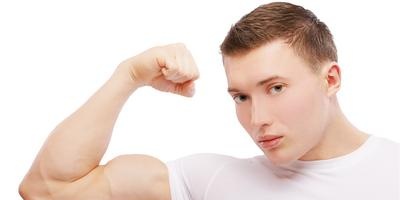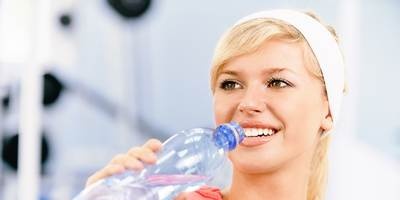|
 The reserve psychophysical capabilities of a person are enormous. They are clearly manifested in big sports. In just a few years, outstanding athletes all over the world have set such records for speed and strength, achieved such precision and coordination of movements that until recently were considered inaccessible to humans. Hundreds and thousands of athletes repeat yesterday's champion records. The reserve psychophysical capabilities of a person are enormous. They are clearly manifested in big sports. In just a few years, outstanding athletes all over the world have set such records for speed and strength, achieved such precision and coordination of movements that until recently were considered inaccessible to humans. Hundreds and thousands of athletes repeat yesterday's champion records.
The success of the masters depends not only on perseverance in training, striving to achieve the goal, but also, as scientists have established, on the energy capabilities of the body.Any organ, any cell receives the necessary nutrients from the tissue fluid that washes them and gives it metabolic products - metabolites that passing into the lymph and blood, are excreted from the body. The totality of liquid media - blood, lymph, tissue and cerebrospinal fluid - constitutes the internal environment of the human and animal body.It is it that provides organs and tissues with energy resources.
These resources also include hormones - unusually active chemical compounds, without which no physiological process takes place.
Until recently, a relatively small number of specifically acting hormones were known, secreted by a few and strictly localized endocrine glands. Literally in recent years, it has become clear that biologically active substances of hormone-like and mediatory action are formed in all cells, tissues, and organs. These substances, influencing individual physiological systems, simultaneously regulate, coordinate and rebuild the functions of the whole organism. Its state and activity are often determined by the physical and chemical structure, specific biological properties of these substances.
Every year, scientists discover and describe, and often synthesize in the laboratory, the most complex chemical compounds such as neurohormones, tissue hormones, metabolites, mediators capable of causing or extinguishing physiological or biochemical processes, accelerating or slowing down their course.
The content and ratio of these compounds in the internal environment determines the hormonal portrait of a person, in other words, the state of the body at the moment, its potential, efficiency, endurance. This hormonal portrait allows, to some extent, to determine the boundaries of the physiological capabilities of the body of both an athlete and a beginner physical cultured, to predict the effectiveness of training efforts and performances in competitions, as well as the ability to perform certain production activities.
 It is known that the improvement of the body's speed-strength qualities is possible only with the full exertion of all its physical and mental powers. The more active the sports activity (training, competition), the more stress. The main load falls on two body systems - sympatho-adrenal and hypothalamic-pituitary-adrenal. Each of them is a combination of nervous, hormonal and mediator elements, the activity of which is interdependent and carried out in full contact. It is known that the improvement of the body's speed-strength qualities is possible only with the full exertion of all its physical and mental powers. The more active the sports activity (training, competition), the more stress. The main load falls on two body systems - sympatho-adrenal and hypothalamic-pituitary-adrenal. Each of them is a combination of nervous, hormonal and mediator elements, the activity of which is interdependent and carried out in full contact.
The work of our laboratory of sports endocrinology of the All-Union Scientific Research Institute of Physical Culture shows that one of the most active biological compounds involved in the coordination of body functions are catecholamines - hormones and mediators of the sympatho-adrenal system.It is the catecholamines that reflect and determine the activity of this system, in which the nervous - sympathetic - department is a single whole with the hormonal - adrenal one. Two hormones, adrenaline and norepinephrine, interact with each other, affecting all body functions.
The state and reactivity, that is, the readiness for the action of the sympatho-adrenal system, is of particular importance for assessing performance, endurance, and sports form. This system is sharply activated during training and competition. And the accumulation of catecholamines in the blood is the first indicator of possible high sports results. Their increased level during physical activity is a clear criterion for the effectiveness of training and a prerequisite for success in the next start.
Experience shows that the excessive content of adrenaline in the blood should be considered as a sign of negative psycho-emotional reactions of the athlete (anxiety, excitement, self-doubt, fear), while the increase in the content of norepinephrine characterizes the degree of readiness for active struggle, indicates persistence and persistence in overcoming obstacles , striving to achieve the goal. We had to observe how shooters, basketball players, hockey players, gymnasts, who had a sharp increase in the adrenaline content in their blood before the start of the competition. performed poorly At the same time, high levels of norepinephrine were associated with success. Competitions turned out to be especially successful when, along with an increase in the content of norepinephrine in the blood of athletes, the content of catecholamine precursors also increased.Thus, the body ensured uninterrupted replenishment of hormone reserves used during physical activity.
And it is no coincidence that adrenaline is called the "anxiety hormone", and norepinephrine is called the "homeostatic hormone", capable of maintaining the relative constancy of the internal environment of the body for a long time, maintaining the activity of cells, organs and physiological systems. In particular, according to our observations, high-class athletes belong mainly to the "norepinephrine type", and beginners and partly unpromising ones - to the "adrenaline" type. The former, with increased stress, mainly release norepinephrine into the bloodstream;
However, it would be wrong to think that the type of athlete is programmed once and for all. During training, the hormonal profile changes. In response to the need to exert physical effort, more norepinephrine is released.
In providing the body's energy potential, along with catecholamines, a huge role belongs to corticosteroids - hormones of the adrenal cortex. The formation of cortisol, hydrocortisone, desoxicorticosterone, their precursors and metabolites is an unusually complex and multistep process. It originates in the hypothalamus, a small but important part of the brain. In its secretory cells, special hormones are formed - releasing, or, as they are now called, corticoliberins. They flow along nerve fibers into the pituitary gland, an endocrine gland that hangs down on a thin stem at the base of the brain.
Under the influence of liberins, adrenocorticotropic hormone is formed in the pituitary gland; entering the adrenal cortex with blood, it stimulates the formation of a number of corticosteroids. The organism cannot exist without them, first of all, because they control its energy.
The hypothalamic-pituitary-adrenal system is activated in the process of practicing any kind of sports. And the faster and more energetically it comes into action, the higher the energy potential of the body, the more chances of success.
Catecholamines and corticosteroids act in roughly the same direction, increasing the body's energy balance. They intensify their activity in extreme conditions, with heavy physical exertion, when full energy is required.When fatigue sets in (and it is inevitable both by the end of training and during the competition of labor activity), the level of catecholamines and corticosteroids in the blood gradually begins to decrease, usually simultaneously and interdependently. But this is by no means always an indicator of fatigue or exhaustion. In particular, the body of a well-trained athlete, adapting to systematic heavy physical exertion, develops the ability to use its hormone reserves more economically (but with the same efficiency). He can do with minimal quantities, much less than the body of a novice athlete or physical culture. But when the need arises to complete a task that is insoluble for an untrained person, the athlete's body mobilizes all its hidden reserves, and his neuro-humoral hormonal regulatory mechanisms begin to work at the maximum mode.
 Energy consumption for any physical activity, especially strenuous and many hours, requires the restoration of resources. In this case, not only catecholamines and corticosteroids are mobilized, but also thyroid and gonadal hormones, other biologically active substances secreted by various organs. Energy consumption for any physical activity, especially strenuous and many hours, requires the restoration of resources. In this case, not only catecholamines and corticosteroids are mobilized, but also thyroid and gonadal hormones, other biologically active substances secreted by various organs.
In the process of recovery, hormones come into play, inhibiting the forces applied by the body during physical exertion. These are acetylcholine, histamine, insulin, serotonin and some others. Their content in the blood of an athlete at the time of, for example, running a hundred meters may be insignificant, but with many hours of walking on skiing or a marathon run, these biologically active substances necessarily accumulate in the blood. The more tired a person is, the higher their content in the internal environment of the body, the more significantly reduced sports results. There comes a period when a person begins to lose strength and, a few fractions of a second before the desired victory, slowing down hormones take over: their high content in the internal environment deprives the athlete of the opportunity to show good results.
What should both a master of sports and a beginner who wants to join physical culture know about?
First of all, that training can influence the composition and properties of the internal environment. They can and should be improved! By adapting to physical activity, the body is able to rebuild its internal environment. Moreover, this is available to both young and elderly people, for whom adequate physical training also helps to activate the sympatho-adrenal system. Through hard work, daily systematic exercises, you can create optimal conditions for the body's activity.
G. N Kassil
|
 The reserve psychophysical capabilities of a person are enormous. They are clearly manifested in big sports. In just a few years, outstanding athletes all over the world have set such records for speed and strength, achieved such precision and coordination of movements that until recently were considered inaccessible to humans. Hundreds and thousands of athletes repeat yesterday's champion records.
The reserve psychophysical capabilities of a person are enormous. They are clearly manifested in big sports. In just a few years, outstanding athletes all over the world have set such records for speed and strength, achieved such precision and coordination of movements that until recently were considered inaccessible to humans. Hundreds and thousands of athletes repeat yesterday's champion records. It is known that the improvement of the body's speed-strength qualities is possible only with the full exertion of all its physical and mental powers. The more active the sports activity (training, competition), the more stress. The main load falls on two body systems - sympatho-adrenal and hypothalamic-pituitary-adrenal. Each of them is a combination of nervous, hormonal and mediator elements, the activity of which is interdependent and carried out in full contact.
It is known that the improvement of the body's speed-strength qualities is possible only with the full exertion of all its physical and mental powers. The more active the sports activity (training, competition), the more stress. The main load falls on two body systems - sympatho-adrenal and hypothalamic-pituitary-adrenal. Each of them is a combination of nervous, hormonal and mediator elements, the activity of which is interdependent and carried out in full contact. Energy consumption for any physical activity, especially strenuous and many hours, requires the restoration of resources. In this case, not only catecholamines and corticosteroids are mobilized, but also thyroid and gonadal hormones, other biologically active substances secreted by various organs.
Energy consumption for any physical activity, especially strenuous and many hours, requires the restoration of resources. In this case, not only catecholamines and corticosteroids are mobilized, but also thyroid and gonadal hormones, other biologically active substances secreted by various organs.









